#The Myth of Normal: Trauma Illness and Healing in a Toxic Culture
Photo
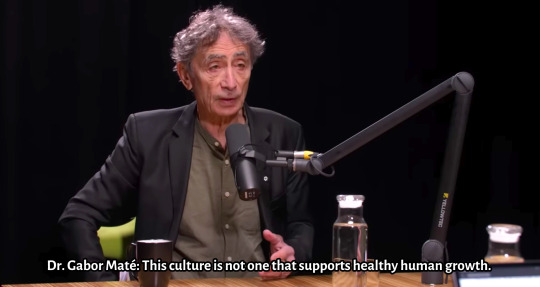
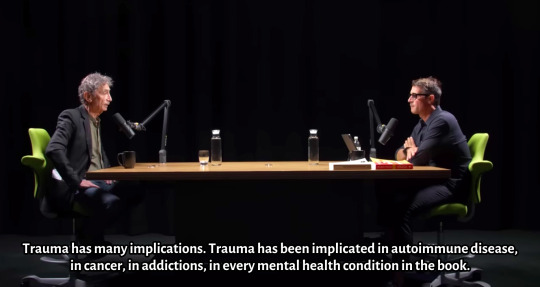

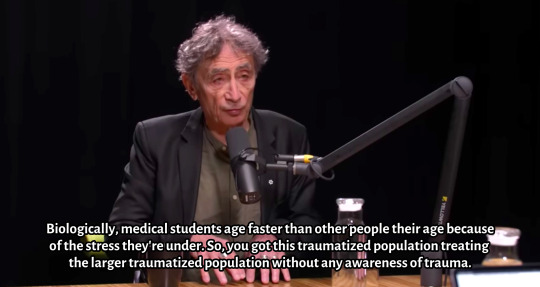

Dr. Gabor Maté On How Trauma Fuels Disease | Rich Roll Podcast
Dr. Gabor Maté: “This culture is not one that supports healthy human growth.
And how social conditions, how inequality of stress, how genderism or racism actually has physiological impacts. They affect our biology. This is not speculation. Trauma has many implications. Trauma has been implicated in autoimmune disease, in cancer, in addictions, in every mental health condition in the book.
But the average medical student does not receive a single lecture on trauma, which is unbelievable, but it’s true. Biologically, medical students age faster than other people their age because of the stress they’re under. So, you got this traumatized population treating the larger traumatized population without any awareness of trauma.
We have certain emotional needs as human beings, that this society not only fails to meet, but actually tramples on very deliberately and very chronically. So, a lot of children get traumatized, not just by what happens to them, but what doesn’t happen to them that should have happened.”
#Dr. Gabor Maté#Gabor Maté#Rich Roll#richrollpodcast#healing#mental health#health#highly recommend#podcast#psychology#biology#science#culture#society#books#quotes#The Myth of Normal: Trauma Illness and Healing in a Toxic Culture
346 notes
·
View notes
Quote
Trauma is when we are not seen and known.
Bessel van der Kolk, as quoted by Gabor Maté in The Myth of Normal: Trauma, Illness, and Healing in a Toxic Culture.
#Gabor Mate#The Myth of Normal: Trauma Illness and Healing in a Toxic Culture#The Myth of Normal#Trauma#Psychology
21 notes
·
View notes
Text
Excerpts from Gabor & Daniel Mate’s ‘The Myth of Normal: Trauma, Illness & Healing in a Toxic Culture’ pg 432-end:
- “There is an unhealthy kind of guilt: a chronic conviction that we are innately blameworthy and should expect, or even deserve, punishment or reproach. In this dim light our faults and failings become evidence of our irredeemable lowliness rather than invitations to grow and do better. This type of guilt, or the fear of it, often strangles a robust “no,” smothering self-assertion: the prospect of others’ disapproval or disappointment triggers the intolerable conviction that we are bad, wrong, inexcusable.” pg 432
- “Most chronic guilt is obsessively single-minded, knowing only one stimulus and exactly one response.” pg 434
- “Guilt speaks in the voice of tightly coiled implicit memory circuits, making it incapable of and impervious to reason. It can’t help being there, and we cannot get rid of it by force. Even by obeying its dictates we shake it off only temporarily--it is sure to raise its clamor again soon. Our acquiescence, and our trap, derives from the fact that we fear guilt, loathe it, are eager to be rid of it. Yes, I’ll comply, we plead. Anything to make you go away. Recognizing guilt for the well-meaning friend it is--doggedly faithful to a fault--we can make room for it. Engaging it in cordial conversation without believing its self-devaluing message, we realize we are talking to a very young and innocent creature.” pg 434
- “When we give guilt a seat at the table, it no longer needs to ransack the entire house.” pg 435
- “Unless their emotional distress can be shared with and validated by attuned adults, children’s necessary developmental narcissism disposes them to take everything personally. It is natural that they should believe that when bad things happen--when life hurts them, when the environment is stressed, the parents unhappy or ill--it is because they are incapable, unworthy, defective.” pg 436
- “Acknowledging that those on whom one depends are incapable of meeting one’s needs would be a devastating blow to a young person. Thus self-blame, like guilt, is an unflagging protector. Believing that the deficiency is ours gives us at least a modicum of agency and hope: maybe, if we just work hard enough, we can earn the love and care we need.” pg 437
- “When you are no longer looking at things from the perspective of the ‘I,’ you feel a newly released potential and sense of connection.” pg 460
- “Healing is outside the thinking mind’s wheelhouse.” pg 464
- “Society is against essence. Everybody around you, wherever you go, is trying to fill holes, and people feel very threatened if you don’t try to fill yours the same way.” pg 468
- “The point is not the big aha, but the arising--sudden or gradual, however it comes--of the consciousness that holds the mind but doesn’t mistake itself for its contents.” pg 468
- “These nonrational parts of ourselves know things about human potential and the nature of life that are untouchable by even the smartest intellect.” pg 482
#gabor maté#daniel mate#the myth of normal#illness#trauma#healing#in a toxic culture#quotes#books#wisdom#philosophy#psychology#psychiatry#body-mind connection#mind-body medicine
15 notes
·
View notes
Text
"We also know from our section on epigenetic that a mom's high stress levels during gestation can negatively influence the genetic function of the offspring, potentially impairing his lifelong stress response capacities. ... Maternal stress during pregnancy has even been correlated with poor makeup of an infant's gut microbial flora (a less healthy mix of bacteria) based on fecal samples taken days, and even months after birth, with a higher incidence of intestinal problems and allergies among these babies."
Turns out all the depressed IBS girlies can blame it on your mom being stressed out while pregnant
(Among the rest of the laundry list of how our society and specifically the U.S. is built in such a way that is unsustainable for the human mind&body)
#nessa says#text post#the myth of normal#gabor maté#daniel maté#trauma illness and healing in a toxic culture#trauma#illness#healing#north america#united states#ibs girlies#book quotes#quotes#bookblr#audiobook
4 notes
·
View notes
Text
Book of the Day - The Myth of Normal
Book of the Day – The Myth of Normal
Today’s Book of the Day is The Myth of Normal written by Gabor Maté and Daniel Maté in 2022 and published by Avery Publishing Group.
Gabor Maté is a Hungarian-born Canadian physician famous for his study and treatment of addiction and his unique perspective on Attention Deficit Disorder. He firmly believes that there is a strong connection between mind and body health. Born in Budapest, Hungary…

View On WordPress
#2022#Avery Publishing Group#Book#Book Of The Day#book reader#book recommendation#book review#bookstagram#booktok#culture#Daniel Maté#Gabor Maté#healing#illness#Raffaello Palandri#The Myth of Normal#toxic#trauma
6 notes
·
View notes
Text
[“Especially in infancy, but throughout childhood, the young human uses the emotional and nervous systems of the caring adults to regulate her own internal states. The interpersonal-biological math is elementary: the more stressed the adult, the more stressed the child. Extensive research has demonstrated that when stressed, parents are less patient and more punishing and harsher with their young children. Stress impairs their capacity to be calm, responsive, and attuned.
As a recent review by leading researchers pointed out, “In more stressful environments for parents, children not only experience less protection from environmental stressors but also are more likely to have stress-inducing relationships with caregivers.” Another study showed that, while elevated stress induced more punitive attitudes in mothers, increased levels of support favorably diminished them. Contemporary science affirms ancient wisdom once more.
Parental stress expresses itself in less overt ways, too, such as distraction and emotional absence. Many parents, though loving, are frequently preoccupied by genuine concerns about relationship issues or economic troubles or personal problems and, as a result, just aren’t as attentive or “present.” This affects development as surely as does parental rage or coldness. “Primate experiments show that infants can undergo severe separation reactions even though their mothers are visually, but not psychologically available,” reports the renowned researcher, psychologist, and theorist Allan Schore. Dr. Schore calls such noncontact “proximate separation”—so close, but yet so far. It’s a dynamic that many children in our society experience, owing to the stresses parents habitually endure. The message the child gets is “You are not worthy of my attention. You must work to earn it.”
Whether or not we explicitly recall such experiences, their imprints survive in our unconscious and in our nervous systems. Making matters more stressful is the alienation imposed by financial hardship. “The relentlessness of modern-day parenting has a powerful motivation: economic anxiety,” the New York Times reported in 2018. “For the first time, it’s as likely as not that American children will be less prosperous than their parents. For parents, giving children the best start in life has come to mean doing everything they can to ensure that their children can climb to a higher class, or at least not fall out of the one they were born into.”
The unintended impact of such fearful, status-driven child-rearing is that the child’s irreducible emotional needs fall secondary to the desperation of parents striving to ensure the academic and financial success of their offspring.”]
gabor maté, from the myth of normal: trauma, illness, and healing in a toxic culture, 2022
496 notes
·
View notes
Text
The Myth of Normal: Trauma, Illness and Healing in a Toxic Culture (Gabor Maté, 2022)
“There is nothing radical about the idea that certain personality traits can pose risks for illness; in fact, it is a restatement in modern scientific terms of insights that date far back. (…)
Whether a person exhibits one, a few, or every one of these features, they all, each in their own way, speak to self-suppression and/or repression.
I have found them not only present but prominent among people with all manner of chronic illnesses, from cancer to autoimmune disease to persistent skin conditions, through a gamut of maladies including migraine headaches, fibromyalgia, endometriosis, myalgic encephalomyelitis (ME), also known as chronic fatigue syndrome, and many others.
In no particular order, these traits are
an automatic and compulsive concern for the emotional needs of others, while ignoring one’s own;
rigid identification with social role, duty, and responsibility (which is closely related to the next point);
overdriven, externally focused multitasking hyper-responsibility, based on the conviction that one must justify one’s existence by doing and giving;
repression of healthy, self-protective aggression and anger;
and harboring and compulsively acting out two beliefs: “I am responsible for how other people feel” and “I must never disappoint anyone.”
These characteristics have nothing to do with will or conscious choice.
No one wakes up in the morning and decides, “Today I’ll put the needs of the whole world foremost, disregarding my own,” or “I can’t wait to stuff down my anger and frustration and put on a happy face instead.”
Nor is anyone born with such traits: if you’ve ever met a newborn infant, you know they have zero compunction about expressing their feelings, nor do they think twice before crying lest they inconvenience someone else.
The reasons these habits of personality, as we might call them, develop and grow to prominence in some people are both fascinating and sobering.
At root they are coping patterns, adaptations originally formed to preserve something essential and nonnegotiable.
Why these features and their striking prevalence in the personalities of chronically ill people are so often overlooked—or missed entirely—goes to the heart of our theme: they are among the most normalized ways of being in this culture.
Normalized how? Largely by being regarded as admirable strengths rather than potential liabilities.”
375 notes
·
View notes
Text
Tips & Tools for Releasing Stored Trauma in Your Body
🌻Somatic Experiencing: Developed by Dr. Peter Levine, Somatic Experiencing can release trauma locked in the body. This method is the result of a combination of stress physiology, psychology, neuroscience, medical biophysics and indigenous healing practices. (Videos on youtube)
🌻Mindfulness and Movements: going for a walk, bike ride, Boxing, Martial arts, yoga (or trauma-informed yoga), or dancing. People who get into martial arts or boxing are often those who were traumatized in the past. They’re carrying a lot of anger and fighting is a great release for them. Exercise helps your body burn off adrenaline, release endorphins, calm your nervous system, and relieve stress.
Release Trapped Emotions:
🍀How to release anger from the body - somatic healing tool
🍀Somatic Exercises for ANGER: Release Anger in Under 5 Minutes
🍀Youtube Playlist: Trauma Healing, Somatic Therapy, Self Havening, Nervous system regulation
🌻 Havening Technique is a somatosensory self-comforting therapy to change the brain to de-traumatize the memory and remove its negative effects from our psyche and body. It has a calming effect on the Amygdala and the Limbic system. 🌼Exercise: Havening Technique for Rapid Stress & Anxiety Relief 🌼Exercise: Self-Havening with nature ambience to let go of painful feelings 🌼Video: Using Havening Techniques to rapidly erase a traumatic memory (Certified Practitioner guides them through a healing session)
🌻Eye Movement Desensitization and Reprocessing (EMDR) is a psychotherapy technique often used to treat anxiety and PTSD. It incorporates rhythmic eye movements while recalling traumatic experiences. This combo changes how the memory is stored in the brain and allow you to process the trauma fully.
🌻Sound & Vibrational Healing: Sound healing has become all the rage in the health and wellness world. It involves using the power of vibration – from tuning forks, singing bowls, or gongs – to relax the mind and body.
🌻Breathwork is an intentional method of breathing that helps your body relax by bypassing your conscious mind. Trauma can overstimulate the body’s sympathetic nervous system (aka your body’s ‘fight-or-flight’ response). Breathwork settles it down.
Informative videos & Experts on Attachment style healing:
🌼Dr Kim Sage, licensed psychologist
🌼Dr. Nicole LePera (theholisticpsychologist)
🌼Briana MacWilliam
🌼Candace van Dell
🌼Heidi Priebe
Other informative Videos on Trauma:
🌻Small traumas in a "normal" family and attachment: Gabor Maté - The Myth of Normal: Trauma, Illness, and Healing in a Toxic Culture
🌻Uncovering Triggers and Pattern for Healing: Dr Gabor Maté
🌻Understanding trapped emotions in the body and footage of how wild animals release trauma
Article: How Trauma Is Stored in the Body (+ How to Release It)
Article: 20 self-care practices for complex trauma survivors
#trauma#healing#attachment styles#trauma informed#somatic#yoga#psychology#neuroscience#mindfulness#Exercise#emdr#eft tapping#sound healing#Breathwork#soothing#nervous system#self care#my post#my information collection#research#trauma healing#attachment trauma#insecure attachment#anxious attachment#inner healing#therapy#psychologytoday#polyvagal#nervous system regulation#relationships
104 notes
·
View notes
Text
“Everything has mind in the lead, has mind in the forefront, is made by the mind,” the Buddha said 2,500 years ago. I return to this phrase of the great teacher Gautama because it is key to understanding our relationship to what we consider real. It is also the bedrock of the therapeutic approach I take to my work and, when I’m conscious, to my personal path. With our minds we construct the world we live in: this is the core teaching. The contribution of modern psychology and neuroscience has been to show how, before our minds can create the world, the world creates our minds. We then generate our world from the mind our world instilled in us before we had any choice in the matter. The world into which we were born, of course, was partly the product of other people’s minds, a causal daisy chain dating back forever.
This may sound grim. Yet the Buddha’s dictum offers a way out, since we remain the ones creating the world we see, the world we think is real, in every moment. And here is where healing comes in. We can do nothing about the world that created our mind, that may have instilled in us limiting, harmful, untrue beliefs about ourselves and others. However — and here’s the good news I alluded to — we can learn to be responsible for the mind with which we create our world moving forward. The capacity to heal is born of the willingness to do just that, to take on that responsibility. Such willingness is not a once-and-for-all declaration but a moment-by-moment commitment, one that can be regenerated when we lose touch with it. I, for one, have to keep reminding myself to do so. Nor is it an invitation to self-imposed naïveté or blithe so-called positive thinking. It is about the willingness to reconsider our entire view.
Gabor Maté, The Myth of Normal: Trauma, Illness & Healing in a Toxic Culture
82 notes
·
View notes
Text
Our other core need is authenticity. Definitions vary, but here’s one that I think applies best to this discussion: the quality of being true to oneself, and the capacity to shape one’s own life from a deep knowledge of that self.
— Gabor Maté, The Myth of Normal: Trauma, Illness, and Healing in a Toxic Culture
47 notes
·
View notes
Text
youtube
Dr. Gabor Maté joins The Chris Hedges Report to discuss his new book, The Myth of Normal: Trauma, Illness and Healing in a Toxic Culture.
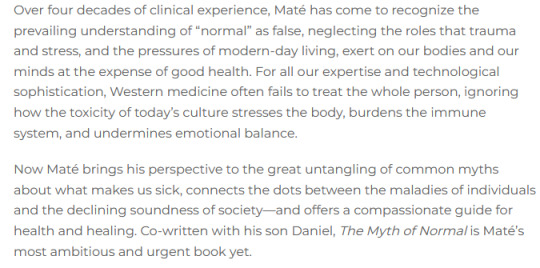
i posted this first during dead online hours and with zero context, but i really think this is a good talk that folks who are mentally ill and terminally online like myself should hear (content warning for assault, addiction, and basically everything trauma related). not a fan of the host dropping the word psychopath in the intro blurb but i don't think that should be used to dismiss Maté's talk.
#just bc mental illness is being talked abt by two old guys in suits doesnt mean their knowledge should always be discredited#some of them know whats up#chris hedges isnt my favourite guy but i like the ppl he gets on his show#Youtube
32 notes
·
View notes
Text
"Trauma is not what happens to you but what happens inside you" is how I formulate it. Think of a car accident where someone sustains a concussion: the accident is what happened; the injury is what lasts. Likewise, trauma is a psychic injury, lodged in our nervous system, mind, and body, lasting long past the originating incident(s), triggerable at any moment. It is a constellation of hardships, composed of the wound itself and the residual burdens that our woundedness imposes on our bodies and souls: the unresolved emotions they visit upon us; the coping dynamics they dictate; the tragic or melodramatic or neurotic scripts we unwittingly but inexorably live out; and not least, the toll these take on our bodies.
Dr. Gabor Maté, The Myth of Normal: Trauma, Illness, and Healing in a Toxic Culture.
85 notes
·
View notes
Photo

Oh boy-Hi Skippy & Friends-The Comedy Club is getting really busy now. The publisher is pushing his book with this paring of “experts” !! "Dr Garbor Mate, aurhor of The Myth of Normal: Trauma, Illness, and Healing in a Toxic Marriage…opps I meant Culture…will join Harry at the live VIMEO event…March 4th.
Over and out for now. PS-I really do appreciate knowing some of you like the creative process happening here in the studio. Thanks so much for letting me share it.
Perfect! We love that you share your artistic creations with us! Thank you dear Pilgrim😃❤️
17 notes
·
View notes
Text
Excerpts from Gabor & Daniel Mate’s ‘The Myth of Normal: Trauma, Illness & Healing in a Toxic Culture’ pg 85-220:
- “A disease is not like a thing. It is an energy flow, it’s a current; it is evolution or devolution that occurs when you’re not awake and connected, and trauma is essentially ruling your life. I think it’s such a mistake to identify it as a thing, because that makes it hard matter when it’s in fact a much more psychological, spiritual, emotional condition.” - V pg 86-87
- “Most of our tensions and frustrations stem from compulsive needs to act the role of someone we are not.” - Janos Selye pg 96
- “Repression disarms one’s ability to protect oneself from stress.” pg 100
- “No other species has ever had the ability to be untrue to itself, to forsake its own needs, never mind to convince itself that such is the way things out to be.” pg 122
- “Our culture too often subordinates felt knowledge to the intellect.” pg 124
- “Emotional rather than intellectual interactions serves as the mind’s primary architects.” pg 126
- “Suppression of innate knowledge is one of medicine’s unfortunate tendencies.” pg 149
- “If it takes a world to raise a child, it takes a toxic culture to make us forget how to.” pg 161
- “The disease paradigm turns a process into a pathology.” pg 215
- “As with most chronic conditions, viewing addiction as a dynamic process to be engaged with rather than a demonic force to be feared or battled can ultimately expand the possibilities for healing.” pg 216
- “Addictions represent, in their onset, the defense of an organism against suffering it does not know how to endure. In other words, we are looking at a natural response to unnatural circumstances, an attempt to soothe the pain of injuries incurred in childhood and stresses sustained in adulthood.” pg 216
- “I have learned that the first question to ask is not what is wrong with an addiction, but what is “right” about it. What benefit is the person deriving from their habit? What does it do for them? What are they getting that they otherwise can’t access?” pg 216
- “When it comes down to it, all addiction’s incentives can be summed up as an escape from the confines of the self, by which I mean the mundane, lived-in experience of being uncomfortable and isolated in one’s own skin.” pg 220
- “Why would the self need to be escaped? We long for escape when we are imprisoned, when we are suffering. Addiction calls to us when waking life amounts to being trapped in inner turmoil, doubt, loss of meaning, isolation, unworthiness; feeling cold in our belly, devoid of hope, lacking faith in the possibility of liberation, missing succor; unable to endure external challenges or the inner chaos or emptiness; incapable of regulating our distressing mind conditions, finding our emotions unendurable; and most of all, desperate to soothe the pain all these states represent. Pain, then, is the central theme. No wonder people so often speak about the benign numbing effect of their addictions: only a person in pain craves anesthesia.” pg 220
#gabor maté#daniel mate#the myth of normal#illness#trauma#healing#in a toxic culture#quotes#books#philosophy#psychology#psychiatry#wisdom#body-mind connection
4 notes
·
View notes
Text
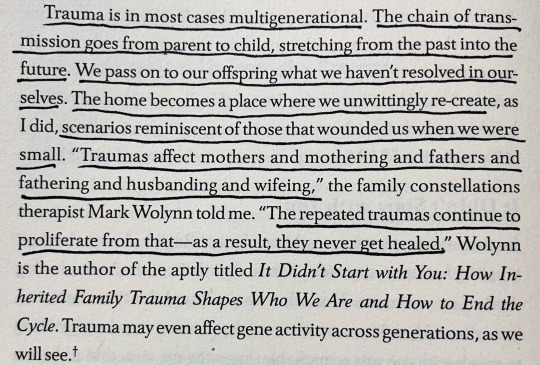
the myth of normal: trauma, illness and healing in a toxic culture by gabor maté
20 notes
·
View notes
Text
[“At long last, doctors now have—more accurately, ought to have—permission to support in good conscience what human beings, with or without any “professionals” assisting, have been doing for hundreds of thousands of years.
As the American journalist Anne Fadiman describes in her illuminating work on the clash of medical cultures besetting Hmong immigrants to the United States, these Asian women stubbornly resisted some of our “best practices” in favor of their own ways, including “squatting during delivery and refusing permission for episiotomy incisions to enlarge the vaginal opening . . . Many Hmong women were used to being held from behind by their husbands, who massaged their bellies with saliva and hummed loudly just before the baby emerged.” In short, they had tradition, intuition, innate body sense, Nature, and—no doubt unbeknownst to them—the most up-to-date science on their side. Not to mention their husbands, who literally had their backs.
The advent of modern obstetrics has brought much to be grateful for, sparing many women and infants from avoidable suffering, illness, and death. The problem is that, along with its triumphs, and in line with the mechanistic approach of Western medicine in general, obstetrical practice ignores the genuine and natural needs of mothers and babies—in fact, it often runs roughshod over them. Bringing infants into the world is not simply a question of pushing and pulling and cutting and catching. It is a major threshold in human development, and how it is crossed has potentially lifelong consequences. By pathologizing the birth process, present-day medical practice contradicts the wisdom of Nature and of the human body. More damningly, it frequently violates even its own commitments to align itself with science and to, first, “do no harm.”
We need not abandon the great achievements of medical work to honor traditional wisdom, rooted in age-old experience. We can embrace both.”]
gabor maté, from the myth of normal: trauma, illness, and healing in a toxic culture, 2022
149 notes
·
View notes